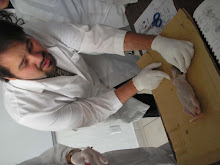The OXIDATION OF A PRIMARY ALCOHOL creates an aldehyde.
This turns to:
H
|
CH3-C-OH
|
H
H
|
CH3-C=OH
That is because when oxidation occurs it is as if an Oxygen comes and takes away 2 Hydrogen (it only has two bonds) but since that leaves the C and the O with an extra bond each they then use then to connect with each other and that creates a double bond between them.
So basically an ALDEHYDE has to have the -CHO group, and they come from a primary alcohol oxidating.
Then we saw what happens when a SECONDARY ALCOHOL oxidates.
You have a secondary alcohol:
OH
|
CH3-C-CH3
|
H
Which turns into the following when an oxygen "passes" by:
O
||
CH3-C-CH3
That is called a Ketone.
We were going to look at what the following grouping was (but we didn't have enough time due to our inability to stay quiet enough to listen and other interrupting events):
R
|
C=O
|
R
We had to look it up ourselves and put it here.
Which based on what I saw on different places is just another way of saying a CH group. so instead of writing the many CH3, you would write the R1 R2 or R3 which are the CH groups that are attached to the Carbon who is attached to the OH. (At least that is what I understood)
Victoria Bracamontes

No hay comentarios:
Publicar un comentario